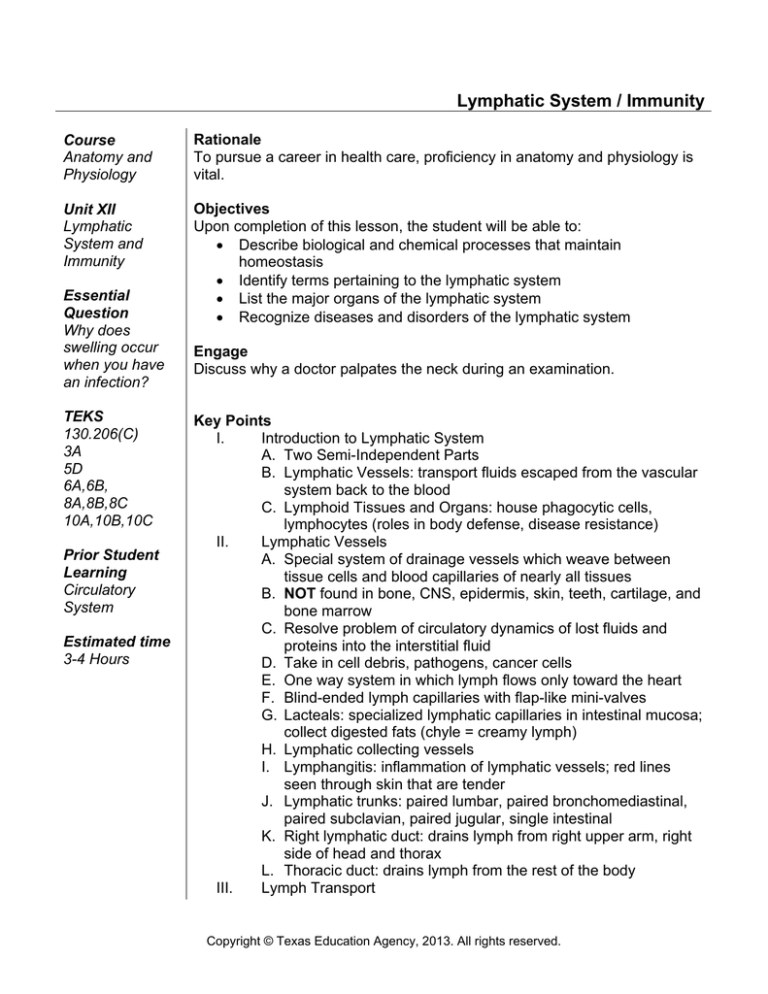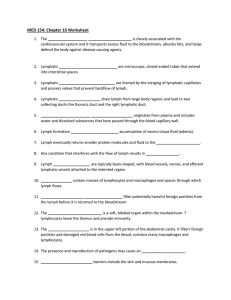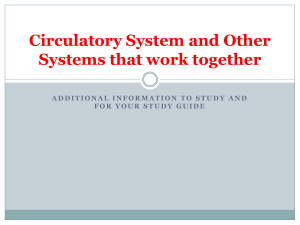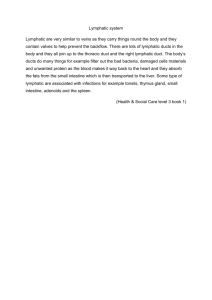Lymphatic System / Immunity
advertisement

Lymphatic System / Immunity Course Anatomy and Physiology Rationale To pursue a career in health care, proficiency in anatomy and physiology is vital. Unit XII Lymphatic System and Immunity Objectives Upon completion of this lesson, the student will be able to: Describe biological and chemical processes that maintain homeostasis Identify terms pertaining to the lymphatic system List the major organs of the lymphatic system Recognize diseases and disorders of the lymphatic system Essential Question Why does swelling occur when you have an infection? TEKS 130.206(C) 3A 5D 6A,6B, 8A,8B,8C 10A,10B,10C Prior Student Learning Circulatory System Estimated time 3-4 Hours Engage Discuss why a doctor palpates the neck during an examination. Key Points I. Introduction to Lymphatic System A. Two Semi-Independent Parts B. Lymphatic Vessels: transport fluids escaped from the vascular system back to the blood C. Lymphoid Tissues and Organs: house phagocytic cells, lymphocytes (roles in body defense, disease resistance) II. Lymphatic Vessels A. Special system of drainage vessels which weave between tissue cells and blood capillaries of nearly all tissues B. NOT found in bone, CNS, epidermis, skin, teeth, cartilage, and bone marrow C. Resolve problem of circulatory dynamics of lost fluids and proteins into the interstitial fluid D. Take in cell debris, pathogens, cancer cells E. One way system in which lymph flows only toward the heart F. Blind-ended lymph capillaries with flap-like mini-valves G. Lacteals: specialized lymphatic capillaries in intestinal mucosa; collect digested fats (chyle = creamy lymph) H. Lymphatic collecting vessels I. Lymphangitis: inflammation of lymphatic vessels; red lines seen through skin that are tender J. Lymphatic trunks: paired lumbar, paired bronchomediastinal, paired subclavian, paired jugular, single intestinal K. Right lymphatic duct: drains lymph from right upper arm, right side of head and thorax L. Thoracic duct: drains lymph from the rest of the body III. Lymph Transport Copyright © Texas Education Agency, 2013. All rights reserved. IV. V. VI. VII. VIII. A. Pumpless B. Milking action of skeletal muscles, pressure changes in thorax, valves C. Very low pressure D. Lymphedema: severe localized edema as result of anything preventing normal return of lymph to blood i.e. tumors, mastectomy Lymph A. Water B. Plasma proteins C. Ions D. Lymphoid cells Lymphoid Cells A. Lymphocytes 1. T Cells: manage immune response, destroy foreign cells 2. B Cells: produce plasma cells which secrete antibodies B. Macrophages C. Dendritic Cells D. Reticular Cells Lymph Nodes A. Lymph “filters” B. Hundreds of nodes C. Found in inguinal, axillary, cervical regions of body, groin, and near gastrointestinal tract D. Have phagocytic macrophages which engulf and destroy bacteria, cancer cells, and other foreign materials Lymph Node Structure A. Most are kidney shaped and less than 2.5 cm in length B. Divided into compartments C. B Lymphocytes - plasma cells - release antibodies D. T Lymphocytes - circulate - surveillance role Lymphoid Organs A. Spleen 1. Located in left side of abdominal cavity 2. Largest lymphatic organ 3. Lymphocyte proliferation, immune surveillance and response 4. Extract aged, defective blood cells and platelets 5. Removes debris, foreign matter, bacteria, viruses, toxins 6. Stores breakdown products of RBCs for reuse 7. Site of RBC production in fetus 8. Stores blood platelets 9. Splenectomy: surgical removal of spleen; Copyright © Texas Education Agency, 2013. All rights reserved. macrophages in liver and bone marrow take of functions of spleen IX. B. Thymus 1. Found in lower neck region and extends into thorax 2. Causes T Cells to become immunocompetent by secretion of thymosin and thymopoietin 3. Size increases through adolescence; decreases in adulthood; by old age it atrophies and is completely replaced by fatty tissue C. Tonsils 1. Ring of lymphatic tissue around the entrance to the pharynx 2. Palatine, lingual, pharyngeal (adenoids) 3. Have invaginations called crypts that trap bacteria and particulate matter 4. “Invite” infection which creates wide variety of immune cells with “memory” for trapped pathogens 5. Lymphocytes remove pathogens, foreign matter D. Peyer’s Patches 1. Lymph nodules found in distal portion of the ileum of the small intestine 2. Also concentrated in wall of appendix 3. Similar to tonsils 4. Destroy bacteria 5. Generate “memory” lymphocytes for long-term immunity E. Mucosa-Associated Lymphatic Tissue (MALT) 1. Peyer’s patches, appendix nodules, tonsils, nodules in bronchi Introduction to Immunity A. Immune System: functional system NOT an organ system; recognizes specific foreign substances and acts to immobilize, neutralize, or destroy them B. Immunity 1. Direct: cell attack 2. Indirect: chemicals and antibodies 3. Together result in highly specific resistance to disease C. Nonspecific (Innate) Defense System 1. Immediate response 2. Two “barricades” 3. First line of defense: external body membranes i.e. intact skin and mucosa 4. Second line of defense: called into action by chemical signals when external defenses penetrated a. Uses antimicrobial proteins, phagocytes, other cells Copyright © Texas Education Agency, 2013. All rights reserved. X. XI. b. Hallmark and most important mechanism = inflammation First Line of Defense A. Intact Skin/Epidermis: forms mechanical barrier that prevents entry of pathogens and other harmful substances into the body 1. Acid Mantle: skin secretions (perspiration, sebum) make epidermal surface acidic which inhibits bacterial growth; sebum contains bactericidal chemicals 2. Keratin: provides resistance against acids, alkalis, and bacterial enzymes B. Intact Mucous Membranes: form mechanical barrier that prevents entry of pathogens 1. Mucus: traps microorganisms in respiratory and digestive tracts 2. Nasal hairs: filter and trap microorganisms in nasal passages 3. Cilia: propel debris-laden mucus away from lower respiratory tract 4. Gastric juice: contains concentrated HCl and protein digesting enzymes that destroy pathogens in stomach 5. Acid mantle of vagina: inhibits growth of bacteria and fungi in female reproductive tract 6. Lacrimal secretions (tears)/saliva: continuously lubricate and cleanse eyes (tears) and oral cavity (saliva); contain lysozyme (enzyme that destroys microorganisms) 7. Urine: normally acid pH inhibits bacterial growth; cleanses lower urinary tract as it flushes from the body Second Line of Defense: Nonspecific Cellular and Chemical Defenses A. Phagocytes: engulf and destroy pathogens that breach surface membrane barriers; macrophages also contribute to immune response B. Natural Killer Cells: promote cell lysis by direct cell attack against virus-infected or cancerous body cells; do not depend on specific antigen recognition C. Inflammatory Response: prevents spread of injurious agents to adjacent tissues, disposes of pathogens and dead tissue cells, promotes tissue repair; chemical mediators released attract phagocytes (and immunocompetent cells) to the area 1. Inflammatory chemicals a. Histamine: from granules of basophils; released in response to mechanical injury, presence of certain microbes, and chemicals released by neutrophils; promotes vasodilation of local arterioles, increases permeability of local Copyright © Texas Education Agency, 2013. All rights reserved. XII. XIII. capillaries - permits exudates formation b. Kinins (bradykinin, etc.): peptide formed from plasma protein found in plasma, urine, saliva, lysosomes of some neutrophils and other cells c. Prostaglandins: fatty acid molecule found in all cell membranes; generated by lysosomal enzymes of neutrophils and other cells; sensitize blood vessels to effects of other inflammatory mediators 2. Four cardinal signs: redness, heat, swelling, pain (5th might be impairment of function) 3. Hyperemia: congestion with blood 4. Exudate: fluid containing proteins such as clotting factors and antibodies 5. Pus: mixture of dead or dying neutrophils, broken down tissue cells, and living and dead pathogens 6. Abscess: inflammatory mechanism fails to clear area of debris; sac of pus walled off by collagen fibers; surgical draining often needed before healing occurs D. Antimicrobial Proteins 1. Interferons: proteins released by virus-infected cells that protect uninfected tissue cells from viral takeover; mobilizes the immune system 2. Complement: lyses microorganisms, enhances phagocytosis, intensifies inflammatory and immune responses E. Fever: systemic response initiated by pyrogens; high body temperature inhibits microbial multiplication and enhances body repair processes Third Line of Defense: Specific Body Defenses, Immune Response A. Functional system that recognizes foreign molecules (antigens) and acts to immobilize, neutralize, or destroy them B. Antigen Specific: recognizes and is directed against particular pathogens or foreign substances (antigens that incite the immune response) C. Systemic: immunity is not restricted to the initial infection site D. Has Memory: it recognizes and mounts an enhanced attack on previously encountered pathogens Cells of the Immune System A. B lymphocytes (B cells) 1. Oversee Humoral immunity B. T lymphocytes (T cells) 1. Non-antibody producing lymphocytes that constitute cell mediated immunity 2. Extremely mobile, circulate throughout body Copyright © Texas Education Agency, 2013. All rights reserved. XIV. XV. XVI. C. Macrophages 1. Engulf foreign particles and present portions of these antigens on their own surfaces for recognition by lymphocytes 2. Remain in lymph organs Antigens A. Substances that are capable of mobilizing the immune system and provoking an immune response B. Also, have self-antigens which our bodies recognize and do NOT attack but other bodies would recognize and attack (basis of transplant rejection) C. Immunocompetent: able to recognize a specific antigen by binding to it Immunological Memory A. Primary Immune Response 1. Occurs on first exposure to particular antigen 2. Lag period of 3 – 6 days (time required for the few B cells specific for that antigen to proliferate and for the offspring to differentiate into plasma cells) B. Secondary Immune Response 1. Re-exposure to particular antigen 2. Faster, more prolonged response, more effective 3. Sensitized “memory” cells on alert Humoral Immunity: Antibody Mediated Immunity (Antibodies in Fluids) A. Antibodies: Immunogloblins - 5 Classes 1. Functions a. Neutralization: masks dangerous parts of bacterial exotoxins, viruses b. Agglutination: mismatched blood c. Precipitation 2. IgM: first antibody class that is released to blood by plasma cells 3. IgG: most abundant antibody in plasma and only one to cross placenta 4. IgA: found primarily in mucus and other secretions that bather body surfaces; major role in preventing entry of pathogens into body 5. IgD: always bound to B cells; B cell receptor 6. IgE: almost never in blood; “troublemaker” antibodies associated with allergies 7. Hybridomas: fusion of B cells with tumor cells to make monoclonal antibodies; have desirable traits of both parent cells B. Active Humoral Immunity 1. Naturally acquired during bacterial and viral infections Copyright © Texas Education Agency, 2013. All rights reserved. 2. Artificially acquired when person receives vaccines (sometimes booster shots required) - attenuated pathogens usually used C. Passive Humoral Immunity 1. Antibodies harvested -- NOT made by own plasma cells 2. Acquired by fetus from mother 3. Infusions of immune serum, i.e. gamma globulin shots after exposure to hepatitis, antivenoms/antitoxins 4. Donated antibodies provide immediate protection that is short lived (2 – 3 weeks) XVII. Cell Mediated Immune Response A. Lymphocytes B. Causes rejection of grafts or foreign organ transplants unless patient is immunosuppressed C. Infections are the major complications of transplants D. Major histocompatibility complex (MHC): cell surface proteins that mark every body cell as self E. T Cells: cytotoxic T cells (CD8), helper T cells (CD4), and suppressor T cells (CD8) XVIII. Organ Transplants A. Autograft: tissue grafts transplanted from one body site to another in the same person B. Isograft: donated by genetically identical individuals i.e. identical twins C. Allografts: transplanted from individuals that are not genetically identical but belong to the same species D. Xenografts: taken from another animal species i.e. transplanting a baboon heart into a human E. Require immunosuppressive therapy XIX. Homeostatic Imbalances A. Immunodeficiencies 1. AIDS: acquired immune deficiency syndrome; destroys helper T cells, resulting in depression of cell mediated immunity 2. Congenital thymic aplasia (DiGeorge’s syndrome): thymus fails to develop 3. SCID: severe combined immunodeficiency disease; depletion of both B and T cells B. Hypersensitivities (Allergies) 1. Immediate: i.e. allergy induced asthma 2. Anaphylaxis: life threatening 3. Subacute 4. Delayed: i.e. skin contact with poison ivy, cosmetics, etc. C. Autoimmune Diseases Copyright © Texas Education Agency, 2013. All rights reserved. 1. Autoimmune thrombocytopenia: platelets destroyed 2. Multiple sclerosis (MS): destroys white matter of brain and spinal cord; possibly triggered by viral infection; demyelinating disease 3. Myasthenia gravis: impairs communication between nerves and skeletal muscle 4. Graves disease: prompts thyroid gland to produce excessive amount of thyroxine 5. Type 1 (juvenile) diabetes mellitus: possibly triggered by viral infection; destroys pancreatic beta cells deficit of insulin and inability to use carbohydrates 6. Systemic lupus erythromatosus (SLE); systemic disease that particularly affects the kidneys, lungs, and skin 7. Glomerulonephritis: severe impairment of renal function 8. Rheumatoid arthritis (RA): systematically destroys joints Activity I. Complete Lymphatic System Worksheet. II. Watch the movie, “Osmosis Jones” and complete questions. III. Complete Lymphatic System Exercise. Assessment Successful Completion of Activities Materials Lymphatic System Worksheet Key Lymphatic System Exercise Key “Osmosis Jones” can be rented or purchased www.Bioedonline.org Accommodations for Learning Differences For reinforcement, the students will make flashcards of the key terms and concepts. For enrichment, the students will research organ transplants or homeostatic imbalances of the immune system and report to the class. National and State Education Standards National Science Education Standards A9-12; C9-12; F9-12; G9-12 National Health Care Skills Standards.01, .07, .09 National Curriculum Standards for School Mathematics S1; S3; S11 Copyright © Texas Education Agency, 2013. All rights reserved. TEKS 130.206 (3) (A) in all fields of science, analyze, evaluate, and critique scientific explanations by using empirical evidence, logical reasoning, and experimental and observational testing, including examining all sides of scientific evidence of those scientific explanations, so as to encourage critical thinking by the student; (5) (D) analyze and describe the effects of pressure, movement, torque, tension, and elasticity on the human body. (6) (A) investigate and describe the integration of the chemical and physical processes, including equilibrium, temperature, pH balance, chemical reactions, passive transport, active transport, and biofeedback, that contribute to homeostasis; and (6)(B) determine the consequences of the failure to maintain homeostasis. (8) (A) analyze the physical, chemical, and biological properties of transport systems, including circulatory, respiratory, and excretory; (8)(B) determine the factors that alter the normal functions of transport systems; and (8)(C) contrast the interactions among the transport systems. (10) (A) analyze the relationships between the anatomical structures and physiological functions of systems, including the integumentary, nervous, skeletal, musculoskeletal, cardiovascular, respiratory, gastrointestinal, endocrine, and reproductive; (10)(B) evaluate the cause and effect of disease, trauma, and congenital defects on the structure and function of cells, tissues, organs, and systems; (10)(C) research technological advances and limitations in the treatment of system disorders. Texas College and Career Readiness Standards VI. Biology A. Structure and function of cells 1. Know that although all cells share basic features, cells differentiate to carry out specialized functions. 6. Know the structure of membranes and how this relates to permeability. F. Systems and homeostasis 1. Know that organisms possess various structures and processes (feedback loops) that maintain steady internal conditions. 2. Describe, compare, and contrast structures and processes that allow gas exchange, nutrient uptake and processing, waste excretion, nervous and hormonal regulation, and reproduction in plants, animals, and fungi; give examples of each. Copyright © Texas Education Agency, 2013. All rights reserved. Lymphatic System Worksheet A. Identify the six structures most commonly associated with the lymphatic system and describe their location and role in preventing illness and/or disease. Organ/Structure Location Role/Function A. B. C. D. E. F. Identify the most appropriate answer for the following questions. B. The lymphatic network begins with microscopic tubes known as: A. Lymph vessels B. Lymphatic capillaries C. Protein filaments D. Lymphatic ducts C. The lymphatic capillaries are found: A. Among vascular capillary beds B. In the brain C. In the spinal cord D. In bone tissue D. What prevents lymph from leaking into extracellular spaces? A. Valves B. Overlapping endothelial cells C. Low pressure in the capillaries D. Gaps between the endothelial cells Copyright © Texas Education Agency, 2013. All rights reserved. E. Which of the following is most like lymphatic vessels in structure: A. Capillaries B. Veins C. Venules D. Collecting ducts F. Which of the following is NOT true of lymph nodes? A. They gradually increase in size and eventually merge into collecting ducts B. They are small C. They are generally oval in shape D. They receive and pass on lymph by way of lymphatic vessels G. Numerous lymphatic vessels merge to form: A. Lymphatic capillaries B. Lymphatic nodes C. Collecting ducts D. Peyer’s patches H. The main collecting vessel for the lymphatic network draining lymph from the left side of the body is the: A. Thoracic duct B. Right lymphatic duct C. Squamous lymphatic duct D. Cranial duct I. Which lymphatic duct empties into the left subclavian vein? A. Thoracic duct B. Right lymphatic duct C. Cerebral aqueduct D. Choroid plexus J. Which of the following statements is FALSE concerning movement of lymph through the body? A. Pressure gradients are essential in the movement of lymph B. The accumulation of protein in interstitial fluid affects lymph movement C. Lifting weights affects lymph movement D. Blood pressure is a major factor in the movement of lymph Copyright © Texas Education Agency, 2013. All rights reserved. K. Identify and describe three mechanisms of movement of lymph through the lymphatic vessels. A. B. C. L. Arrange the following lymphatic vessels in sequences from smallest to largest or most distal to most proximal within the lymphatic system. Collecting ducts Lymphatic capillaries Lymphatic vessels M. Define Antigens N. Define Antibodies Copyright © Texas Education Agency, 2013. All rights reserved. Lymphatic System Worksheets – KEY 1. Organ/Structure Location Role/Function Organ/Structure A. Lymph Nodes Location throughout the body but concentrated in the neck, groin, armpit, and abdominal cavities Spleen left side of the abdominal cavity just below the diaphragm - LUQ in the mediastinum just superior to the heart Role/Function remove foreign particles and cleans lymph fluid from D. Tonsils mouth and throat (3) pairs: palatine, pharyngeal, and lingual destroy pathogens in the mouth and throat region E. Peyer’s Patches within the walls of the small intestines F. Bone Marrow (Red) middle of flat bone and the epiphysis of long bones destroys pathogens trying to pass through the intestinal wall production of blood cells and the maturation of B lymphocytes B. Spleen C. Thymus Gland a blood reservoir and filter for removing foreign particles and old cells from the blood and lymph site of T lymphocyte maturation 2. B 3. A 4. C 5. B 6. A 7. B 8. A 9. A 10. D 11. A. Pressure gradients from the extra cellular space into the lymphatic capillaries and lymphatic vessels B. Moves toward the collecting ducts and toward the heart by way of skeletal muscle pumps C. Assisted in movement toward the heart by the presence of one way valves within the lymphatic vessels 12. Lymphatic capillaries, Lymphatic vessels, Collecting Ducts 13. Antigens : any foreign substance that stimulates an immune response 14. Antibodies: proteins produced by cells that react with antigens by binding with them to form an antigen-antibody complex Copyright © Texas Education Agency, 2013. All rights reserved. Video: “Osmosis Jones” 1. What is in saliva that protects us from microorganisms? 2. What do lymph nodes do? What is their function? 3. What is Osmosis Jones? 4. What does inflammation indicate? 5. What does glandular swelling indicate? 6. What causes the odor in sweat? 7. How are foreign bodies handled in the nasal cavity (lines of defense)? 8. How are allergens handled? 9. What causes an increase in nasal secretions? 10. How do antihistamines work? 11. How does the body detect foreign invaders? 12. Which cells are involved in the detection of foreign invaders? 13. How do flu shots work? How do they confer immunity? 14. Explain the defense mechanism of Osmosis Jones. 15. What does the hypothalamus control? Copyright © Texas Education Agency, 2013. All rights reserved. 16. What is a pimple? 17. What is a blackhead? 18. How and where was the antihistamine disposed of? 19. How does the virus take control of the cell? 20. What kind of WBC is Osmosis Jones? 21. What killed the virus? 22. What is normal temperature? 23. What happens if the temperature is higher than 105 degrees? 24. What did Osmosis Jones retrieve to save the Father? 25. What is the moral of the story? Copyright © Texas Education Agency, 2013. All rights reserved. Lymphatic System Exercise 1. Tim, 19 years old, was in a motor vehicle accident. He was not wearing a seat belt and hit his abdomen on the steering wheel. In the ER he was examined and found to have a rigid distended abdomen with LUQ pain. His hemoglobin on the CBC was 10 grams. His V/S were: B/P-100/48, P-110, and R-36. All of these symptoms are indicative of a ruptured __________________. This organ is in the LUQ of the abdomen. 2. Kathryn, a 9 year old girl, is rushed to the hospital after fainting. Her blood pressure is alarmingly low, and her mom states that she collapsed after being stung by a bee. Kathryn will be treated with ____________________. 3. Mrs. R has recently emigrated from Tahiti. She is experiencing edema and enlargement of the lower extremities. Her doctor’s dx has been aided by the knowledge of her emigration. She was told her condition would be a chronic condition. Mrs. R’s dx is ____________________. 4. Scott, 4 years old, has fever and chills, is achy all over and has a sore throat. On palpation of his neck the doctor notices his glands are swollen. This swelling of the glands is called _____________________________. 5. Mr. C has seen his doctor for the following symptoms: fever and chills, pain and edema to his R groin area and a red streak originating from his R groin and radiating down his leg. These sx are descriptive of ___________________________. Copyright © Texas Education Agency, 2013. All rights reserved. KEY - Lymphatic System Exercise 1. 2. 3. 4. 5. Spleen An epinephrine injection Lymphedema Lymphadenitis Lymphangitis Copyright © Texas Education Agency, 2013. All rights reserved.





